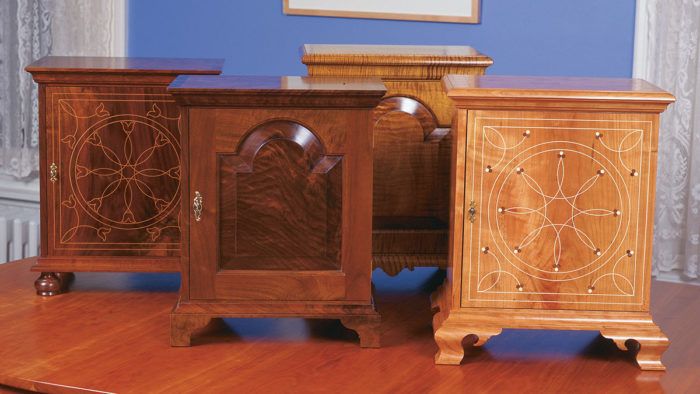Pennsylvania Spice Box
Highly figured wood and hand-cut joinery make this chest a showpiece of craftsmanship
Synopsis: Building a spice box involves a variety of joinery, including hand-cut dovetails, machined joints and moldings, raised-panel construction and precise drawer fitting. It’s a great way to learn, practice, or show off your woodworking skills, writes D. Douglas Mooberry. Spice boxes don’t use a lot of wood, so use the best you can find. The box detailed in this article has bracket feet, a tombstone raised-panel door, and typical interior drawer layout. The carcase is more intricate than it appears, he says, and a large, detailed exploded drawing illustrates the piece. Mooberry explains how to mill the drawer dividers, mill the molding, and shape the feet, and then how to build the nine drawers. He uses brass hardware for the hinges and pulls and finishes the piece with shellac and wax.
When I started a woodworking business, my biggest obstacle was me. Though I was 22 years old, I looked 16. When making house calls, potential clients would eye me with an annoyed expression that seemed to say, “What, your father couldn’t make it to our appointment?” To convince them that I was the craftsman and did indeed know something about woodworking, I started bringing a spice box that I had made. Once they saw the hand-cut joinery, pleasing design and incredibly figured wood, they felt more comfortable.
Thanks to spice boxes, I am still woodworking 15 years later. Building one involves a variety of joinery, including hand-cut dovetails—lots of dovetails—machined joints and moldings, raised-panel construction and precise drawer fitting. A spice box, or valuable chest, is a great way to learn, practice or show off your woodworking skills (see the photo below).
Spice boxes have a heritage that goes back several centuries. The term spice box is really a misnomer. These small chests originally may have been used for storing rare spices, but they were usually filled with valuables such as jewelry and documents.
Because spice boxes don’t demand a lot of wood, use the best you can find. The more figured the wood, the better. The box I designed for this article has bracket feet, a tombstone raised-panel door and a typical interior drawer layout. The primary wood, meaning everything you see without pulling out the drawers, is walnut. The secondary wood is poplar. The hardware includes a pair of brass butt hinges, a lock and nine drawer pulls.
The carcase is more complex than it appears
Don’t be misled by the size of a spice box when setting a timetable for building one. Although it’s about as big as a portable television, it’s going to keep you busy for some time.
You’ll need at least 12 bd. ft. of walnut and 6 bd. ft. of poplar or some other secondary species. I begin by milling out the wood for the two sides, top and bottom. You’ll need stock that can finish out at in. wide and in. thick. I always surface the face on the joiner to get it flat and then plane it to get consistent thickness. I look at what my board will yield and determine how best to use it. This lets me center a beautiful flame pattern or stay away from a hidden crack or a knot.
From Fine Woodworking #124
For the full article, download the PDF below:
Fine Woodworking Recommended Products

Jorgensen 6 inch Bar Clamp Set, 4 Pack

Bessey EKH Trigger Clamps

Starrett 12-in. combination square





















Log in or create an account to post a comment.
Sign up Log in